'Tis the season for charitable giving.
During the holidays, we all start thinking about giving back and making donations to charity. In fact, nearly one third of all charitable donations are made during the month of December, as a result of the tax benefits they can offer at the year’s end, along with the desire to give during the holidays. With well over one million charities to choose from, deciding where to donate becomes an overwhelming task.
In the spotlight: Four charities to donate to this holiday season
To make the process easier, InMyArea has compiled a list of four charities doing incredible work that are more than deserving of your donations this holiday season, as well as year-round. We've also gathered some tips and resources to make choosing a charity as simple as possible. That way, you’ll never have to wonder if your money is being put to good use.
Alliance of Hope for Suicide Loss Survivors
When compared to individuals who have lost loved ones to sudden natural causes, “individuals bereaved by suicide are 80% more likely to drop out of school or quit their jobs – and 64% more likely to attempt suicide.” Suicide loss survivors go through grief and pain that many of us could never imagine, which puts them at very high risk. Someone who understands this grief is Ronnie Susan Walker, the founder of Alliance of Hope for Suicide Loss Survivors.
Walker, a clinical health counselor who lost her stepson to suicide, founded Alliance of Hope in 2008. When she first founded the charity, Walker simply wanted to create a site that could provide healing and support to other survivors. What started as a “labor of love” has grown to an online community of over 15,000 members.
"She always says that it was like a grenade going off in the family, where each of us was wounded and struggling to survive in our own way."
Heather Shadur is Ronnie Susan Walker’s daughter and the Director of Public Relations & Fundraising for Alliance of Hope. Shadur grieved the loss of her stepbrother along with her mother and the rest of her family. “In our circumstances,” Shadur recalls, “[my mother] always says that it was like a grenade going off in the family, where each of us was wounded and struggling to survive in our own way … For suicide loss, most people don’t realize that for the people who are closest – like the mothers, spouses, best friends, or siblings – it’s as if every bone in someone’s body is broken, but you can’t see it.”
Because suicide loss survivors’ wounds aren’t typically external, it can be difficult for them to understand and express their pain. Many survivors are left to grieve alone, feeling as though no one else understands what they are going through. Though every survivor’s loss is unique, the organization provides a community of survivors who are experiencing similar grief.
When a suicide loss survivor visits Alliance of Hope’s website, “they can find our support group,” Shadur says, “which is an online forum overseen by a mental health professional and a trained team of moderators who are themselves suicide loss survivors. It’s a peer-based forum where people can come 24/7, and they can receive support from people who understand what they’re going through.”
Many of the forum’s users live in rural areas where in-person support groups are hard to find. Shadur notes that other members live in urban areas where there may be more support groups available, but often times the meetings don’t fit the survivor’s schedule, or they might not even be able to get themselves out of bed to go, as the grief is so great. Alliance of Hope allows suicide loss survivors to receive support at any time, day or night, no matter where they are.
In addition to the online forum, Alliance of Hope offers several other resources for users. The organization provides distance counseling for those who wish to speak to a professional over the phone or through Skype. The charity’s website also has a directory for individuals to find in-person support groups in their area. Alliance of Hope runs a blog with hundreds of posts written by suicide loss survivors about their own experience and dealing with different kinds of loss. The site also provides resources about the grief journey and coping with various aspects of grief, whether it’s dealing with guilt, anger, confusion or trauma.
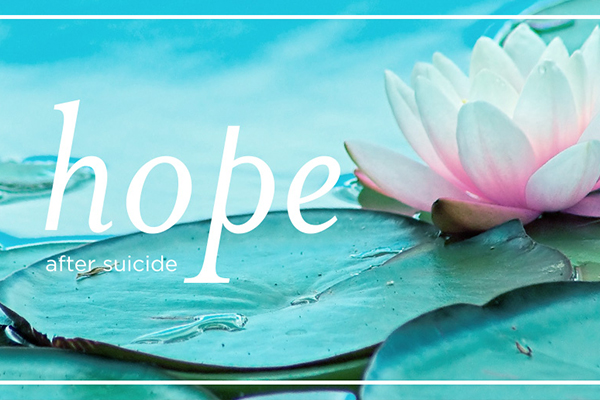
Why Donate to Alliance of Hope?
When you donate to Alliance of Hope, the funds go directly towards providing support to survivors of suicide loss. Shadur notes that “a lot of people don’t understand what it takes to run the forum. It’s heavily moderated, because we want to make sure it remains a healing culture. We get thousands of people who are going through the darkest hours of their life, so we make sure that the atmosphere stays a healing place. There’s a lot of work needed to do that … we really run on a shoestring budget.”
Without the support of its donors and those who volunteer their time to help moderate the site, Alliance of Hope couldn’t offer the serve the thousands of grieving individuals who use the site. According to Shadur, the organization receives “emails, we call them expressions of gratitude, on a daily basis from people who say that Alliance of Hope is their lifeline, or that the Alliance of Hope has saved their life.”
The support that Alliance of Hope provides is known as “postvention,” which is a form of suicide prevention. By providing support and healing to those who have lost a loved one to suicide, Alliance of Hope is able to help reduce the risk that the survivor will attempt suicide.
You can read many of these stories and expressions of gratitude on GreatNonprofits, where hundreds of individuals have posted about how Alliance of Hope has impacted them. GreatNonprofits is a well-known and trusted evaluator site for charities. Alliance of Hope has received a GreatNonprofit Top-Rated Nonprofit Award for 2018, which indicates that it is one of the site’s highest-ranked charities, according to members, volunteers, and the community.
The holiday season can be an incredibly difficult time for those who have lost loved ones to suicide, which makes this a great time of year to donate. To donate to the organization's holiday campaign or start your own personal fundraising page on the site, click here. If you or anyone you know is a suicide loss survivor, you can find immediate support here at the Alliance of Hope website.
Puppies Behind Bars
Puppies Behind Bars is a charity that “trains prison inmates to raise service dogs for wounded war veterans and for first responders, as well as explosive-detection canines for law enforcement.” For veterans who suffer from PTSD, along with other mental and physical injuries, service dogs can improve their quality of life.
Gloria Gilbert Stoga, the founder of Puppies Behind Bars, realized that puppies could not only change the lives of veterans, but that they could also positively impact prison inmates.
"They’re able to do something that’s going to make a big difference in the life of a veteran or first responder who sacrificed a lot for us all.”
When the organization’s puppies reach the age of eight weeks, they are placed in one of seven New York prisons with an inmate who is a dedicated puppy raiser. These inmates have gone through at least a year of training before receiving a puppy. For the following two years, the inmate builds a loving bond with the dog, training it to become a service dog for a wounded veteran or first responder.
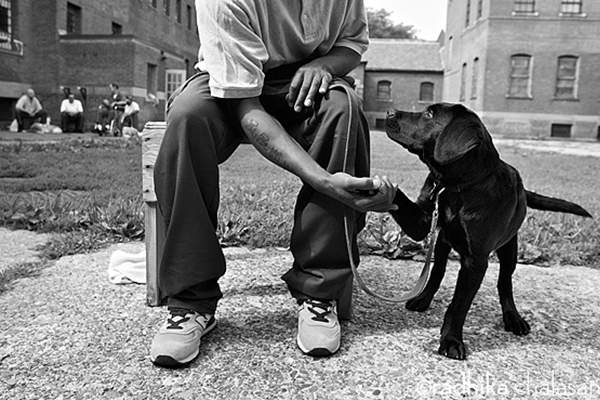
According to Eric Barsness, the organization’s Director of Development, the puppies receive 24/7 care, with multiple hours of exercise and training every day. The puppy is exposed to several different environments and people, as they go wherever the inmate goes throughout the day. The puppy also goes on at least one trip outside of the prison each week. By the time the dog is ready to work for a veteran, they will have learned over 90 commands.
Barsness notes that the puppy raisers are “given an opportunity to make a real contribution to our society. They’re being asked to work very hard, and it is hard work. It’s not just all fun and play with the dogs. They’re able to do something that’s going to make a big difference in the life of a veteran or first responder who sacrificed a lot for us all.” This opportunity is something that the inmates take great pride in. Not only that, but the dogs also serve as devoted companions to the inmates.
Once the dogs are ready to graduate, the veteran goes through two weeks of intense training. The veterans learn how to use the commands the dogs have learned, along with various other topics that are important for living with a service dog. A great deal of this training is done by the inmate puppy raiser, which is very rewarding for both the inmate and the veteran. “The inmate has to give up this dog that they’ve raised and that they love. It’s a very hard thing for them to do,” Barsness comments, “but they take pride in the fact that the dog is going on to do something so important.”
Why donate to Puppies Behind Bars?
Since its founding, Puppies Behind Bars has trained over a thousand dogs. Dog owners know that raising a dog is not cheap. Barsness estimates that “by the time a dog goes home with a veteran, we’ve invested around $40,000 in that dog.”
The organization also pays for the veteran’s flight and hotel while they are going through the training, making it possible for the veteran to receive the dog without financial burden. Puppies Behind Bars also provides support to the veterans for the rest of the working dog’s life, making annual visits to check in on the pair. The charity goes above and beyond to ensure the success of the pair, even watching the service dog if the veteran needs to go to the hospital for treatment and for other special circumstances.
Not only does your donation go towards raising these service dogs, but it also helps change the lives of veterans across the country and inmates in New York. “For the inmate puppy raisers,” Barsness states, “they’re experiencing unconditional love 24 hours a day. So they get the joy and the sense of fulfillment that it can bring … We hear from a lot of the inmates that they have children and it’s something very positive that they can talk to their children about when they visit. It’s also something very positive that they can write home about.”
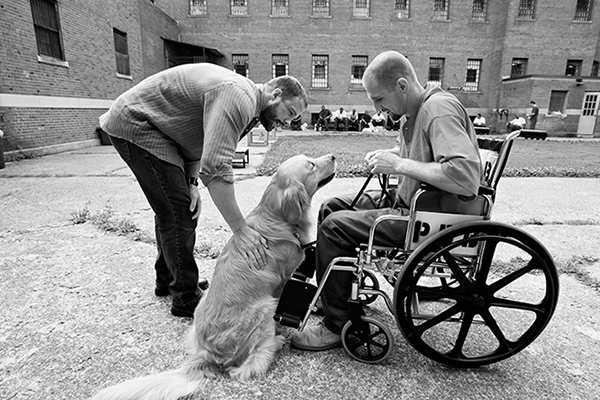
The skills and experiences that the puppy raisers acquire can also make the process of reentering society after being paroled much easier. Many are able to find work as dog trainers or veterinary assistants. Four former puppy raisers have even been hired by Puppies Behind Bars to help train the inmates and veterans. As for the veterans, Barsness says:
“The dogs have a really profound effect of providing a freedom that a lot of these men and women haven’t experienced in years … They’ve given up work and they don’t take their kids out; they don’t go to the movies anymore; they don’t go to dinner. Just going to the supermarket can be a terrifying experience. We hear from them all the time that with the dog at their side, they gain the confidence to reenter the world. A lot of them go back to work or back to school. We particularly hear from them and from their spouses and kids that they’re able to do things as a family again that they haven’t been able to do in years. Another thing that we hear all the time is that a veteran might go from taking 15 or 20 prescription drugs a day, down to taking one or two or none, and that they no longer need their anti-anxiety medications or that they no longer need the sleeping pills they were taking.”
Puppies Behind Bars has received 11 consecutive four-star ratings on Charity Navigator, a popular site that evaluates and ranks charities. To donate to Puppies Behind Bars, visit their website.The organization also sells calendars and holiday cards with pictures of their puppies that make for great gifts. If you know of a veteran or first responder in need of a service dog, they can fill out an application here.
Achilles International
Achilles International is an organization that encourages athletes with disabilities all over the world to stay active and meet their goals. Michael Anderson, the Director of the New York City chapter for Achilles International, says “we empower athletes with all different types of disabilities to mainstream into the running community and to help them lower barriers, build self-esteem, and lead an overall more fulfilling life. When I say disability, it could be all types. We have runners who have traumatic brain injuries, runners with autism, blind runners, runners who are amputees, etc.”
The organization was founded by Dick Traum, a man who lost his leg after a tragic accident. Traum began running with a prosthetic after his accident to stay healthy, and he went on to run the New York City Marathon in 1976. “Ever since then it has shined a light on people with disabilities that really want to get involved in athletics and competitions, and that really led to Achilles being founded 35 years ago,” Anderson comments.
Through its 20 chapters in the United States and many other chapters worldwide, Achilles serves thousands of runners with disabilities. In the communities that the organization serves, Achilles hosts workouts a few times a week. Volunteers serve as guides to each athlete to motivate the runners and help them complete the workouts safely.
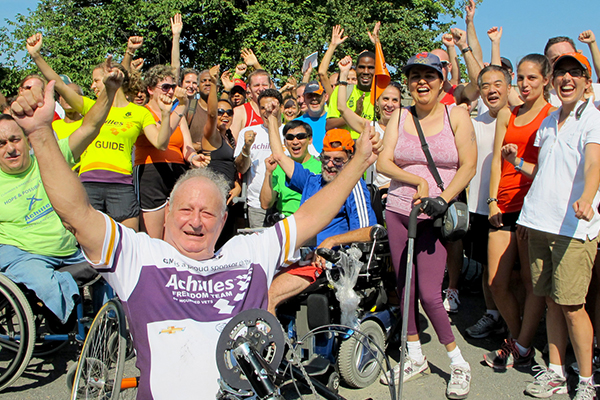
Other Achilles members and guides simply want to get out and walk. Anderson says, “we may have an elderly blind person who’s just looking to get out for a good 30 minute or hour-long walk. We want them to be able to do that and experience it in a place like Central Park, where you can really experience the crunching of the leaves under you in fall, and the seasons are changing, and you can smell it in the air. It’s just a wonderful experience to have a guide out with them.”
Achilles also hosts several races throughout the world called Hope & Possibility races. One of these races takes place in Central Park each year. According to Anderson, “It’s the biggest race of its kind that mainstreams able-bodied athletes with athletes with disabilities all running together in a race. We had over 5,000 people cross the finish line in Central Park.”
“These athletes will say to me, ‘I never thought that I could even get out and run a mile or even a 5K.’ They later find themselves working up to and eventually succeeding at running an entire marathon."
Achilles International puts on several other events for athletes with disabilities to get involved in, including the Freedom Team, which helps wounded veterans train to run marathons. The organization also has a program that helps more than 12,000 children with disabilities across the country get out and stay active. Hundreds of athletes with disabilities participate in the Achilles Marathon Tour, running in one of various marathons that take place throughout the country each year.
Why Donate to Achilles International?
Achilles International is running a Giving Tuesday campaign, that will make each and every donation go farther. On November 27th, Facebook and PayPal will match a total of $7 million in donations. After that day, the Lakin Challenge begins and all donations will be matched one-to-one up to a total of $50,000.
Achilles International allows athletes to meet, and often surpass, goals that they never believed they could accomplish. Anderson notes:
“These athletes will say to me, ‘I never thought that I could even get out and run a mile or even a 5K.’ They later find themselves working up to and eventually succeeding at running an entire marathon. Often times what they’ll say after they’ve run their first race or their first marathon is, ‘What’s next?’ That’s what changes their lives. They find themselves constantly looking to take on the next challenge, succeed in it, and set goals.”
A blind runner may have never been able to run a marathon without the help and encouragement of an Achilles guide. A child with a prosthetic may have never had the confidence to try and run before attending an Achilles workout. “Someone that donates to Achilles, they are helping not only blind athletes, but also athletes with other types of disabilities, kids on the spectrum, wounded veterans, all of these things. We need funding to keep these programs alive,” Anderson says. Donations go towards things like race entry fees, training gear, and transporting athletes with any equipment they may need like a wheelchair. You can make a donation on the Achilles website.
For those who love to run, or even just walk, Achilles is always looking for volunteers. Whether you’d like to be a guide for an athlete or help set up for a local race, your time and support can make all the difference for a runner with a disability. If you’d like to volunteer, or you know someone who would like to become an Achilles athlete, click here.
Achilles International has a four-star rating on Charity Navigator, as well as a gold-level GuideStar status, which demonstrates its commitment to transparency. GuideStar is a resource that provides data and profiles on nonprofits, receiving over nine million visitors last year.
Mercy Corps
Mercy Corps provides aid to more than 40 countries across the world with a mission “to alleviate suffering, poverty and oppression by helping people build secure, productive and just communities.” Since its founding in 1979, Mercy Corps has helped more than 220 million people. It is one of the world’s top global humanitarian aid and development organizations.
“We believe we must go beyond emergency aid to create more resilient communities, and we believe communities are the best agents of their own change to do that."
Mercy Corps goes beyond one-time emergency aid to create lasting change in the communities it serves. Claire-Elizabeth Gonnard, a Media Relations Associate for Mercy Corps, says “We believe we must go beyond emergency aid to create more resilient communities, and we believe communities are the best agents of their own change to do that. We learn who the changemakers are in each community and start there.Then we partner with governments, businesses, civil society—whoever can help us create transformational change. Last year we invested 65 percent of our program spending into long-term solutions that build stronger communities for tomorrow.”
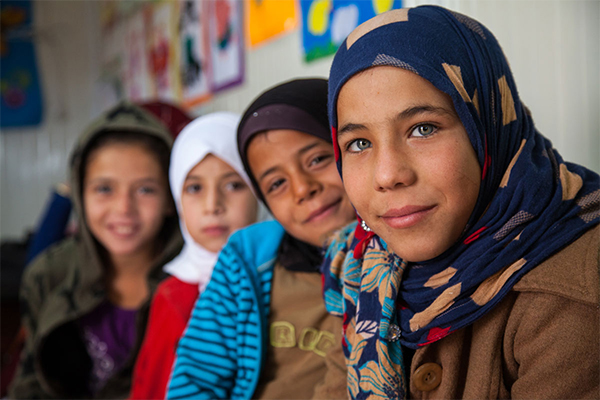
One recent project that Mercy Corps has developed serves Niger, one of the poorest countries in the world. With large average households and and an average annual per person income of less than $200, malnutrition is common. Mercy Corps created a “husband school” to encourage men to become more involved in the home. The goal of this school “is to teach husbands how — and why — to take an active role in their homes, with lessons about family planning, health and nutrition,” Gonnard notes. “This helps them partner with their wives to make well-informed decisions that will benefit their families, like preparing balanced meals, improving household sanitation and spacing out pregnancies.” This program and other similar initiatives have reached 30,000 people in 2018 alone.
Another Mercy Corps initiative takes place in Nepal, “one of the poorest and most disaster-prone countries in the world. Households typically have few resources to protect themselves and recover from frequent natural disasters such as earthquakes and floods,” Gonnard comments. “To help families better prepare for and recover from disaster, Mercy Corps collaborated with a regional intergovernmental organization to strengthen the early warning system in western Nepal … As a result, communities are better prepared for rapid-onset emergencies, will have the ability to recover from disaster shocks more effectively, and will sustain less human, financial and socio-economic losses.” Almost 164,000 people are now utilizing this system.
Mercy Corps has provided aid to those in need in several other ways. Their team has helped 2.5 million people survive the crisis in Syria, rebuilt water systems in the Democratic Republic of Congo to provide clean water to 2.5 million people, and helped 270,000 individuals “expand their businesses and earn higher incomes” in countries throughout the world.
Why donate to Mercy Corps?
Mercy Corps’ goal for Giving Tuesday on November 27th is to reach 2,000 donors for the day. Once they have reached 1,000 donors, all donations will be matched up to $100,000. You can double your impact just by donating on Giving Tuesday. To make a contribution, you can donate here.
When you donate to Mercy Corps, the funds go towards projects like those listed above, that are directly changing the lives of those in need around the world. These programs help create sustainable, resilient communities.
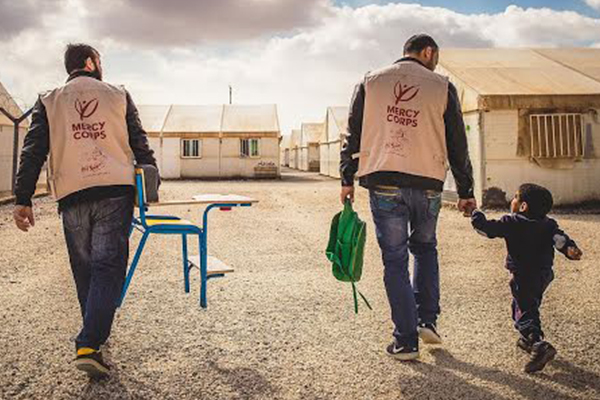
The results of Mercy Corps efforts are tangible, so you know that your money is being put to good use. 87 percent of the organization’s resources go towards funding programs, with only 13 percent going towards administrative costs.
According to Gonnard, “What makes [Mercy Corps] special are our 5000+ dedicated team members — in fact, 87 percent of our team is from the countries where they work — and the incredibly resilient people, communities and organizations we’re partnering with around the world that truly believe a better world is possible. It’s about shining a light on the people working to overcome some of the world’s toughest challenges.”
The organization’s team members are passionate and dedicated to the work that they do, as most of them come from the countries receiving aid, and they know that they’re making a real difference. Mercy Corps is always looking for new team members. You can apply for open positions on their website.
Mercy Corps consistently receives three and four-star ratings on Charity Navigator. The Better Business Bureau (BBB) is another organization that evaluates charities, and Mercy Corps meets all 20 of the BBB’s criteria for charity accountability.
Choose your own charity with Charity Navigator
If there is cause you'd like to donate to this holiday season that isn't listed above, there are plenty of resources that make finding a charity as easy as possible. Websites like Charity Navigator are a great resource that do the heavy lifting for you by evaluating thousands of charities, so you don’t have to. It’s like the Yelp of charitable giving.
Charity Navigator was founded by a man who, just like the average donor, was looking to donate to a good cause and had no idea where to start. He decided to build a resource to eliminate some of the confusion that comes with choosing a charity. InMyArea spoke with Ashley Post, the Communications Manager for Charity Navigator, to learn more about this resource and to get some tips on choosing a charity.
So how do you find the right charity? Simply start by thinking about what causes or issues are important to you. Post says, “I often encourage donors to just take five or ten minutes and sit down and really think about the first few things that come to mind: If they would want to see change in the world or if they just want to make the world a better place, how would they do that? What are those things that matter most to them?”
People will often donate to a cause that hits close to home. Whether you have a family member with autism, a friend who has passed away as a result of cancer, or you’re a dog lover, personal experiences can influence where you decide to donate. It’s important to consider your values and personal relationships when donating.
Take your time and really think about where your money is going, just as you would for any other sort of investment. After you’ve chosen a cause that’s important to you, it’s time to do your research. Post notes:
“At Charity Navigator we look at charities a lot like making an investment in social good, and people would certainly do their research before making any type of monetary investment in something where they expect to see a return.”
Each organization that Charity Navigator has evaluated will have its own profile and a rating, ranging from one to four stars. These ratings are broken down into two categories: Financial Health and Accountability & Transparency, which gives you a holistic look at the charity. Post comments, “Three and four-star charities are charities that are doing really great work. They’ve proven that they are achieving their mission, and they’re remaining fiscally healthy. They are being responsible with donors’ dollars, and they’re also providing information back to donors either through reports or through information on their website.”
Each charity profile includes other important information, like what percentage of the charity’s funds actually go towards its mission. Once you’ve chosen a specific charity that appeals to you and aligns with your values, Post “encourages donors to do a gut check. If it feels weird, it probably is. If something feels off, you don’t have to donate. This is especially true of any types of charities that contact you over the phone or weird email solicitations. Just be mindful and always do your research. If anything looks like it’s a little fishy, it doesn’t hurt to call or do a quick Google search.”
Most charities will be more than happy to answer your questions over the phone or via email. If the organization has a local facility or chapter and you happen to live nearby, you could even stop by in person.
Post comments, “Because there are so many charities out there, you could be thinking, ‘I want to help women in Cambodia for this specific cause,’ and there’s a chance that there is an organization doing that exact thing. How would you have ever found them otherwise?”
Editor's Note: InMyArea.com is not affiliated with or sponsored by any of the charities or other organizations listed.


